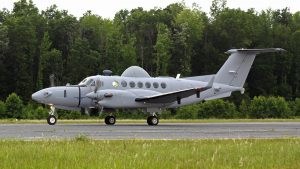
The U.S. Army’s focus on intelligence-gathering aircraft has shifted to sophisticated threats, marking a change from a decade of investment in low-end capabilities such as the RC-12 (pictured). Courtesy Photo
Awkward questions arose two years ago when the U.S. Air Force chose to cancel the $6.9 billion J-Stars Recap program—while citing the Joint Stars fleet’s vulnerability to projected advances in adversary air defense technology after 2025.
After all, if the Air Force doubted the ability of a commercial aircraft derivative to perform the Northrop Grumman E-8C’s ground-surveillance mission, how long could similar aircraft in the Defense Department’s fleet—such as the Navy’s Boeing 737-derived P-8A or the Air Force’s own Boeing RC-135-—expect to continue operating with a reasonable chance of survival?
A new program emerging within the Army’s airborne intelligence branch raises the question again. If the Army’s program proceeds as planned, a small fleet of fewer than 10 large derivatives of a commercial aircraft—potentially, a P-8, Gulfstream G550-derived C-37 or Bombardier Global 6000-based E-11—could be fielded by around fiscal 2028, performing a mission that combines many of the capabilities of the E-8C J-Stars and signals-intelligence-gathering RC-135 Rivet Joint.
The program revives and expands the concept for the Aerial Common Sensor (ACS), which attempted to package an advanced, multi-intelligence-gathering payload integrated by Lockheed Martin onto the Embraer 145 regional jet. But the sensor package proved to be more than 40% heavier than the payload limit of the ERJ-145, which forced the Army to cancel the $879 million engineering and manufacturing development program for the ACS in January 2006. Over the next decade, the Army’s priorities for the fixed-wing intelligence fleet shifted to supporting counterterrorist and counterinsurgent operations.
The Pentagon’s focus is back to competing with powerful and sophisticated militaries, forcing sweeping changes in modernization priorities. For the Army’s intelligence branch, the technology priority has shifted from technology that can identify radio-frequency triggers for improvised explosive devices to electronic receivers that can eavesdrop on communications between an adversary’s headquarters and field units, along with long-range radars that can detect mobile, high-value targets for a new class of surface-to-surface missiles with ranges far beyond the Army’s current 185-mi. limit.
“As we started to pivot to that peer-to-peer threat, we realized that our ability to stand off and see deep was very limited,” says Christian Keller, the Army’s project director for sensors-aerial intelligence.
Last year, the Army quietly started searching for a new intelligence-gathering Aerial Intelligence, Surveillance and Reconnaissance (AISR) aircraft, which would be equipped with a new High-Accuracy Detection Exploitation System (HADES).
The Army wants a “business-jet-class” aircraft that can reach at least 41,000 ft., or 64% above the service ceiling of the de Havilland Dash 8-Q315 EO-5C Airborne Reconnaissance Low-Multifunction (ARL-M), which replaces the Dash 7-derived EO-5 fleet starting this year.
“[The Army is] looking at several different platforms,” says Keller. “There are some efforts to look at [aircraft] the other services have that we’d be able to take and use as-is or with modifications to include our own sensor capabilities, or potentially a new platform altogether.”
Asked if the P-8 or C-37 aircraft represent the performance the Army seeks for AISR, Keller replied: “You’re in the right area.”
The Army’s funding for AISR, however, remains uncertain. The Joint Requirements Oversight Council has approved the initial capabilities document for the service’s Multi-Domain Sensor System (MDSS) concept, which includes the AISR fleet as the most near-term priority. Follow-on plans include an Army-operated satellite constellation in low Earth orbit and stratospheric airships. So far, the Army has requested only about $50 million in the fiscal 2021 budget for the MDSS, requiring significant new investment in the service’s fiscal 2022 spending request.
“It is a significant amount of money,” says Keller. “From the perspective of [the intelligence branch] and the Army leadership, they look at this as a game changer and as something that could really enable us.”
The newly developed HADES payload would provide many of the same onboard capabilities, but from a higher vantage point, extending the range of the Army’s most sophisticated electronic eavesdropping equipment, along with a synthetic aperture radar (SAR) that can track moving targets on the ground.
As planned, the Army’s future AISR aircraft will match the performance of the Air Force’s RC-135 and retiring E-8C but with a payload that performs the functions of both.
China and Russia have displayed anti-radiation missiles with ultra-long range, presenting a perfect weapon against a derivative of a commercial airliner or business jet with a radiating sensor. Despite the rising threat, the Army is not particularly worried about the relevance or survivability of such an aircraft.
A critical factor in the Air Force’s decision to cancel the J-Stars Recap involved the range of the sensor. The APY-7 radar on the E-8C has a listed range of more than 96 mi. Russia advertizes the 40N6 interceptor in the S-400 air defense system, which has been exported to China, with a 400-km (250-mi.) range. If an aircraft such as the E-8C must be stationed beyond the range of the 40N6 or the 40N6e export version, the APY-7 radar would be unable to see into enemy territory.
Army officials recognize the problem but suggest there are workarounds, even for a nonstealthy, radiating aircraft.
“I could also see a case where you might be deploying other capabilities of a platform like this, such as air-launched effects and things of that nature,” says Keller.
Air-launched effects (ALE) refers to a broad range of systems in development. Recoverable ALEs are essentially air-launched unmanned aircraft systems. Disposable ALEs represent munitions or nonkinetic systems such as decoys and jammers. If deployable ALEs become part of the AISR requirement, the manned aircraft could act as a mothership and preserve a capability to operate in the presence of long-range anti-radiation missiles.
“When the risk is high, they’re probably going to fly this thing in a way where it’s going to maintain a safe distance and still be able to do its job,” says Keller.
The high-altitude AISR also is expected to perform other roles. Along with the smaller, King Air-derived RC-12, the EO-5 fleet maintains a vigilant presence on the Korean Peninsula, for example. The aircraft perform routine patrols, developing an electronic “pattern of life” of North Korean military emitters such as radars, communications systems and jammers.
“I see the [AISR] very much doing the same thing but on a more capable platform, with more capable sensors and flying higher and looking deeper,” says Keller.
Responsibility for the AISR acquisition is divided within the Army acquisition system. The program executive officer for aviation is responsible for acquiring the aircraft, a process that will begin in fiscal 2022 or 2023. Keller’s office is directing the acquisition process for HADES, the sensor payload. A fly-off to compare the capabilities of the companies seeking to supply the HADES package is scheduled for next year.
“From there we’re going to select a set of sensors and be able to have that ready for whenever we do have a platform in place,” Keller says.
As the acquisition unfolds, the Army is seeking to avoid the same errors that doomed the ACS program 14 years ago. The two key lessons it has drawn from the ACS experience are to be careful about how much authority to give the contractor over the aircraft and sensor integration process, and to select an aircraft with plenty of spare capacity.
“We gave the contractor full authority to pick the airframe and all the sensors,” says Keller. “We had issues—a lot of it was [size, weight, power and cooling]. And then when we tried to make some adjustments on the [concept of operations], we didn’t get a lot of support [from the contractor]. So we learned a lot of hard lessons that way. Those lessons were not lost on the Army, and [we’re] making sure we pick a platform that has margin and the ability to grow.”
Brandon Pollachek (AASKI Technology, Inc.) Public Affairs Officer,
PEO-IEW&S (Support Contractor)
Suite D2327-B/Bldg 6002 Aberdeen Proving Ground North, MD 21005-1846
Comm: (443) 861-7820
DSN: 848-7820
